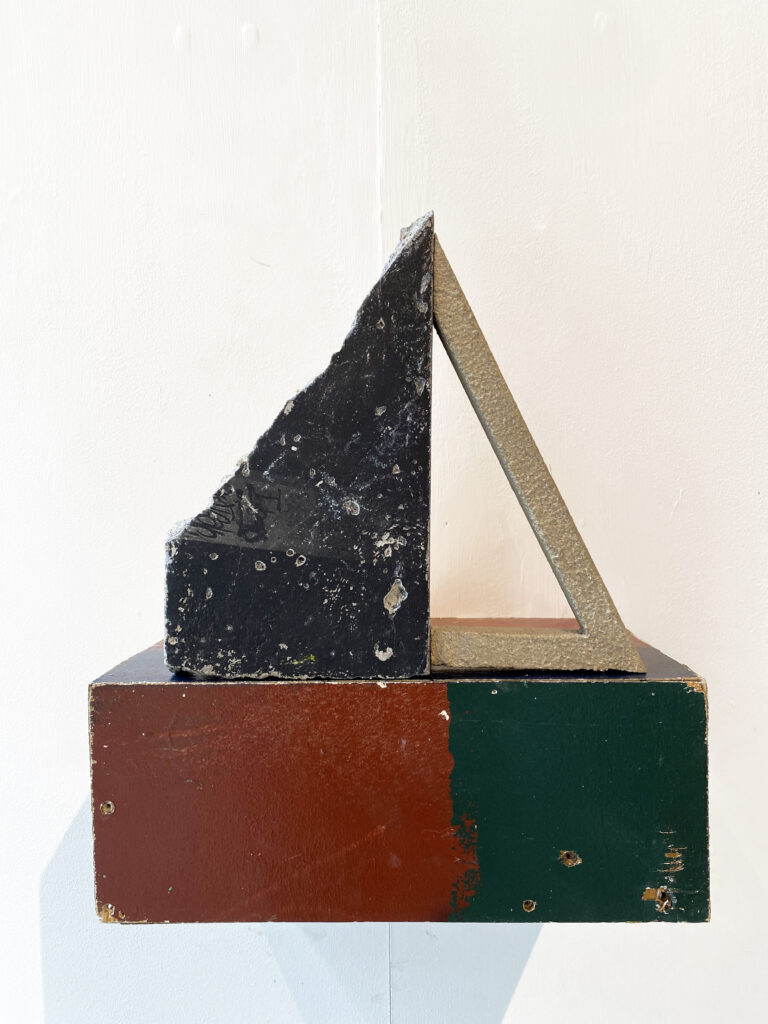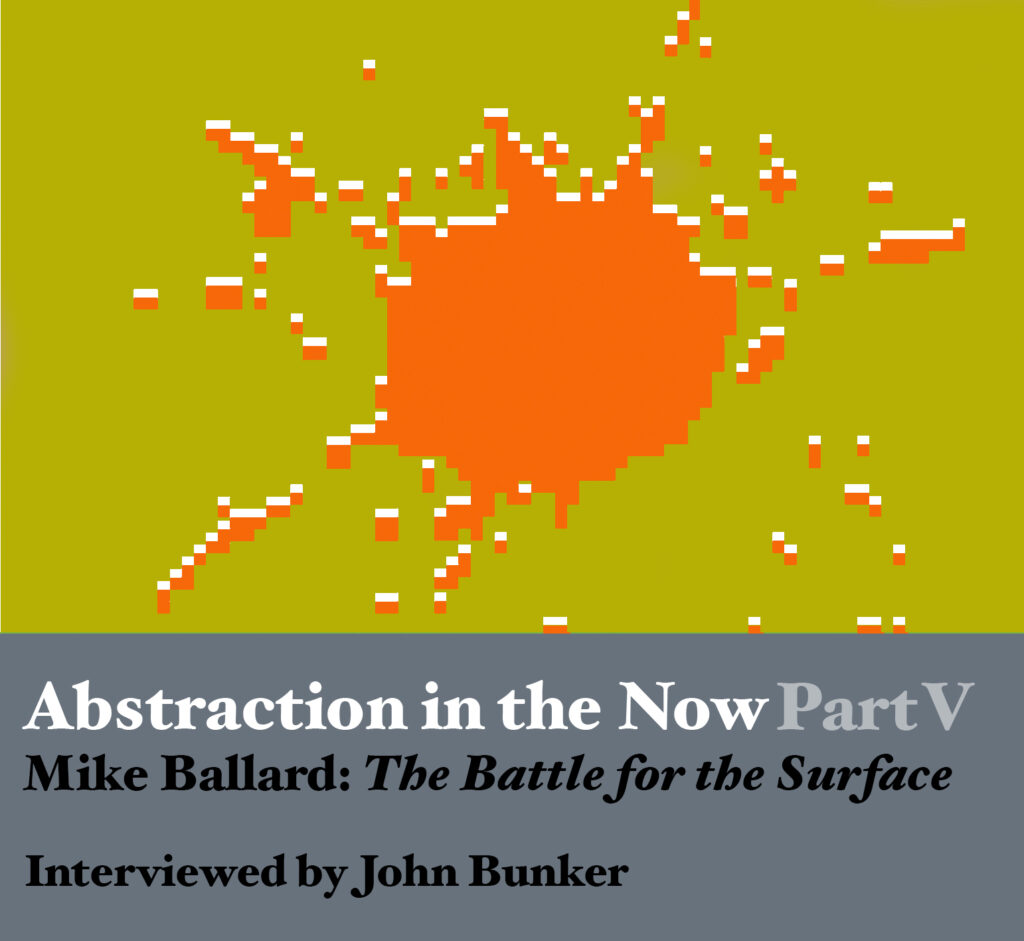
For the fifth instalment of our ‘Abstraction in the Now’ series, John Bunker talks to Mike Ballard, an abstract artist who moves freely between two and three dimensions, creating installations that combine painting, printmaking, photography, and image transfer with boards, hoardings, fixtures and found objects harvested from contested city spaces.
Mike Ballard (b.1972) lives and works in London. He is the winner of the 2020 Jack Goldsmith Award for Sculpture, and his work has been included in the RA Summer Exhibitions, 2018-2020. Other recent shows include ‘Territorial Gestures’ at OHSH Projects; ‘Gutter Snipe’ at the Bomb Factory Art Foundation; and ‘Adapt the Collapse’ at Union Gallery London.
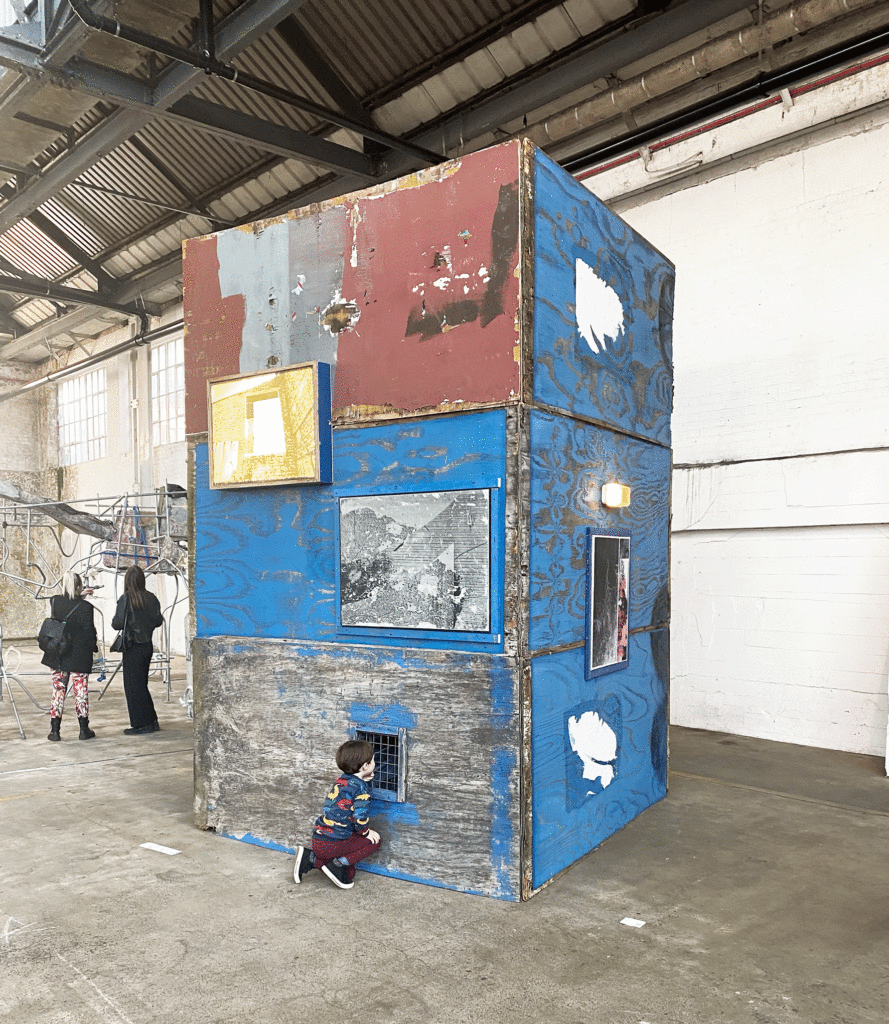
JB: Can you remember the first abstract painting or sculpture to make a real impression on you?
MB: The work that comes to mind straight away is a subway car painted by Futura 20001https://en.wikipedia.org/wiki/Futura_(graffiti_artist) I first saw this painting in the mid 1980’s: it really stands out from the majority of New York subway graffiti, which consists of very graphic, very stylized, character and letter–based work. This painting by Futura 2000, on the other hand, was a mix of faded colours, gestural lines and swirls across the whole subway carriage, with a formation of cracking rocks carrying his signature in the middle of all the colours.
It really made me think about how painting need not depict anything. This was clearly a painting, about paint and what you can do with spray paint. Futura’s early pieces always remind me of Katrina Grosse’s work; she got her style from graffiti, without a doubt.

JB: What does working abstractly offer you as an artist?
MB: Ultimately, freedom. Freedom from representation and narrative. Working abstractly is a matter of trying to grasp fleeting thoughts and inner visions; although a lot of my abstract work is actually derived from the visible world, its found compositions, accidental patinas, residue.
When I do work on a painting that is purely about paint, without photographic reference, I really try not to think about anything, and just let my hands move the paint to where it feels right.
I’ve always thought it’s so much harder to make a great abstract painting than representational one.
JB: Do you see yourself as an abstract artist or as an artist who works with aspects of abstraction?
MB: I just see myself as someone who makes work. I jump between different modes of painting: photorealism, work made with toner transfers, or paint-as-paint.
It depends where my mood takes me. Some weeks I really want to get stuck into some detailed painting, remaking a photograph of some abstract composition; other days I work purely with photographs, not paint.
I work with aspects of abstraction; I don’t really like labelling or categorising myself, I go where I’m happiest, and I get bored easily, ADHD kicks in and I need to make something else.
I’m amazed at artists who just do the same thing all the time, they must be so bored or scared; I hate this idea of sticking to making one type of work which you’re then known for and trapped by.
I think abstraction is not so much a practice or way of painting as a mindset; one of freedom.
JB: Could you talk about what roles found materials, photography, print and improvisation play in your painting process?
MB: I love finding materials and compositions in the world. I get really excited when I see a great set of hoardings that have been weathered and graffitied and painted over again and again, and all the layers have built up and it all looks fucked, the wood’s delaminating, but it’s so beautiful, and the most amazing abstract paintings have formed accidentally from the weathering and the overpainting of graffiti, it’s just all there. It’s so satisfying to see, and to get hold of the material, take it back to the studio and start editing it; it’s as if it’s pointless for me to paint, as it’s already there and been done for me with a looseness and freedom no painter could emulate.
Photography plays a huge part in my practice. I’m photographing stuff on the street all the time. I walk around the city a lot, flaneuring, looking for the slightest small marks, gaps between shops, sticker residue, scratches, torn posters; tiny found gestures that I then blow up big and transfer to my canvasses. Once I’ve amplified the found gestures, they take on a new power which then inspires me to interact more with them, building up layers. Many times I’ll think a painting is finished, only to review it months later and realise it’s nowhere near done, and ‘remix’ it.
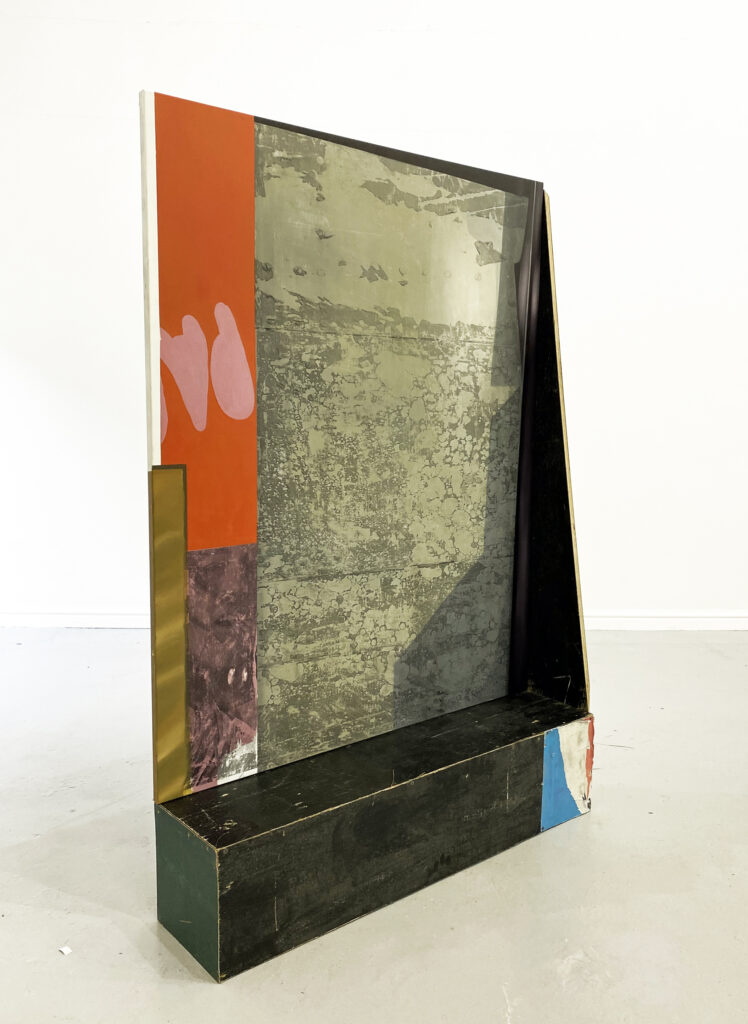
JB: Your exhibitions of work in both painting and sculpture often show dynamic interplay between mediums. Could you talk about why you bring together work in two and three dimensions?
MB: I like to bring 2D and 3D works as ‘remixes’ of my everyday environment. I see my work functioning visually very much like sampling functions aurally within Hip Hop, which I love and am influenced by: I take these disparate found elements from everyday wanderings and then decontextualize them, chop and flip them into a brand new form. So to bring them together in a show is very much like arranging an album, I think that’s exactly what I’m trying to do when I make an installation. The paintings form the backdrops to my sculptures and the sculptures lend their weight and presence to the paintings. I like there to be a tension between them.
JB: I’m intrigued by your choice of a Futura 2000 piece because it seems to me that it is a mixture of object (train) and image (painting). This fusion of image and object in your work seems to operate at different registers. You describe the Futura piece as ‘clearly a painting, about paint, and what you can do with spray paint’– which it is; but it happens to be placed on the side of a subway train, which means it can’t be simply ‘about paint’ in the way that it might be possible to argue a painting by Ellsworth Kelly is. Has your view of the Futura painting shifted, now that you have passed through years of study, and have your own practice as an artist working with abstraction?
It’s refreshing to note that there seems to be very little angst about the references and influences you bring into your work from outside the realms of ‘high art’. Yet, I’d like to know more about influences from ‘Fine Art’ that you bring to bear on your process. Are there any major or minor figures that have lead the way for you? The formal language of a great deal of your 3-dimensional work evokes the work of certain American minimalists of the 1960s- in particular, Ronald Bladen, Tony Smith, Robert Morris, Richard Serra. Are you conscious of your work belonging to a certain tradition of ‘specific objects’? And do you set out to deliberately subvert that tradition?
Your larger sculptural works remind me of the ‘art world scandal’ surrounding Richard Serra’s steel plate sculpture ‘Tilted Arc’ that literally divided a Manhattan city square in half. It seems thoroughly apt that during the Reaganite 1980s this strange intersection between gargantuan minimal abstraction and the real world caused such anger and resentment amongst the office workers who had to deal with the dark, brooding and wonky sheet of steel every day as they moved between buildings in the square. I would have loved to have seen some of the graffiti that had to be constantly scrubbed off the sculpture until a judge finally ordered ‘Tilted Arc’s removal and destruction. Serra argued that his sculpture would encourage viewers to reconsider how they navigated the public space, but many of the workers saw the sculpture as a barrier blocking out their view of the square and casting dark shadows over the public space. I refer to all this because elsewhere you have mentioned how urban hoardings act as barriers that say ‘keep out’ or ‘this is mine, keep off’. They are signs defining particular kinds of territories. Do you think, in your work, you are drawing attention to the way that urban spaces and ownership of segments of those spaces are defined? Do you think Serra’s ‘Tilted Arc’ and other minimalist public sculpture from that period, that purport to be somehow beyond representation of any kind, inadvertently carry a kind of symbolism? Are your sculptures metaphors for the body? How comfortable are you with psychological readings?
MB: I get what you’re saying about the Futura piece being on a train, but all paintings are painted on something. That piece still moves me; but I’ve seen and learnt a lot about art since my first encounters with the subway art of New York. Sterling Ruby’s paintings move me in the same way, they’re just so undeniable, so bold and fresh, so uncompromising. His new turbine paintings look amazing.2https://gagosian.com/exhibitions/2022/sterling-ruby-turbines/
I also remember first seeing David Ostrowski’s paintings, and thinking these are terrible, just a small amount of spray paint, they looked so lazy and unimpressive. Then, the more I looked, the more I saw the magic, the effortlessness that was everything it needed to be. I see artists trying to make it look like they don’t care, trying hard to make it look like they’re not trying, but it’s too contrived and obvious, whereas Ostrowski’s paintings are everything: I think they’re incredible, minimal perfection. His work made me really think a lot about painting and what it can be.

Regarding my sculptures, I was not aware of most of the artists you mention. Serra, yes, of course, but the rest, I hadn’t heard of, apart from Tony Smith, andI see the comparison; but I was not aware of his work when I first started making my sculptures. That’s an interesting story about the Serra sculpture. I do think that my work draws attention to ideas of ownership. My sculptures are metaphors for the history of movement and represent the in-between state of demolition and regeneration. They also carry a cargo of memory, and are a kind of fantasy architecture. I think they work on different levels.
I don’t think about art traditions or art history. I feel that my sculptures are purely a way to present the surfaces I’ve collected, or to emulate certain forms I see in the built environment. If it wasn’t for the patina and stains, the weathering, if I just made the sculptures out of new wood, they’d have no weight or provenance. The history of the materials makes the sculptures.
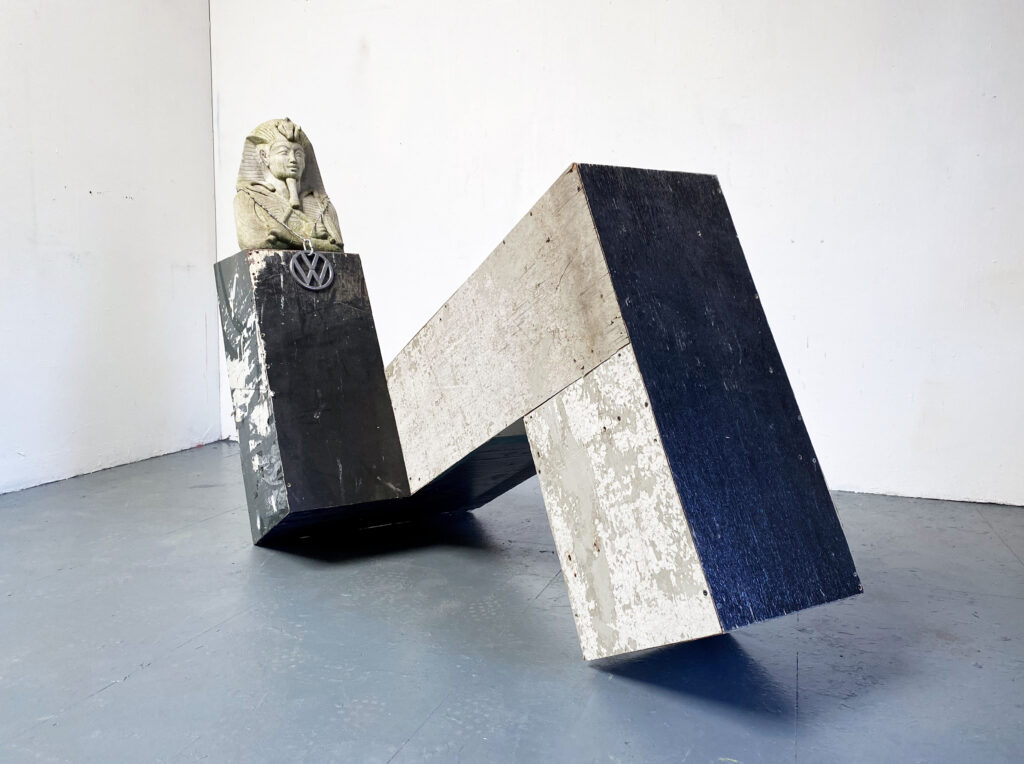
JB: I’d like to bring in the writings of Mark Fisher in relation to your work. Fisher tried to articulate a contemporary sense of the weird and the eerie, consciously attempting to explore these terms in relation to the neoliberal economic and social paradigm by which he believes we are currently enslaved.
For Fisher, the eerie ‘is constituted by a failure of absence or by a failure of presence. The sensation of the eerie occurs either when there is something present where there should be nothing, or there is nothing present when there should be something’; and he singles out a particular type of the eerie ‘that pertains to ruins or other abandoned structures. Post-apocalyptic science fiction, whilst not in itself necessarily an eerie genre, is nevertheless full of eerie scenes.’3Mark Fisher, M., ‘The Weird and the Eerie’, 2016, Repeater Books, P61- 63
Fisher is of relevance here, because although you have spoken in celebratory terms about your fascination with Hip Hop culture, there is also a darker, and I would argue, ‘techno-gothic’ edge to your work. I’m thinking here about your interest in the aesthetics of the weathered and decayed aspects of urban landscapes: rotting facades, cracked tarpaulin, stained concrete.
Your installation piece ‘Territorial Gestures’ for OHSH Projects, which occupied an empty shopfront and basement space, bodied forth a sense of the eerie, evoking the transitory and vampiric nature of contemporary capitalism, and the way it leaves its traces in the architecture of commerce. Your large-scale photo of an urban hinterland devoid of human presence, with tower blocks rising up in the distance, simultaneously deadpan documentary image and brooding, desolate no-man’s-land, acted as a strange backdrop for the sculpture.
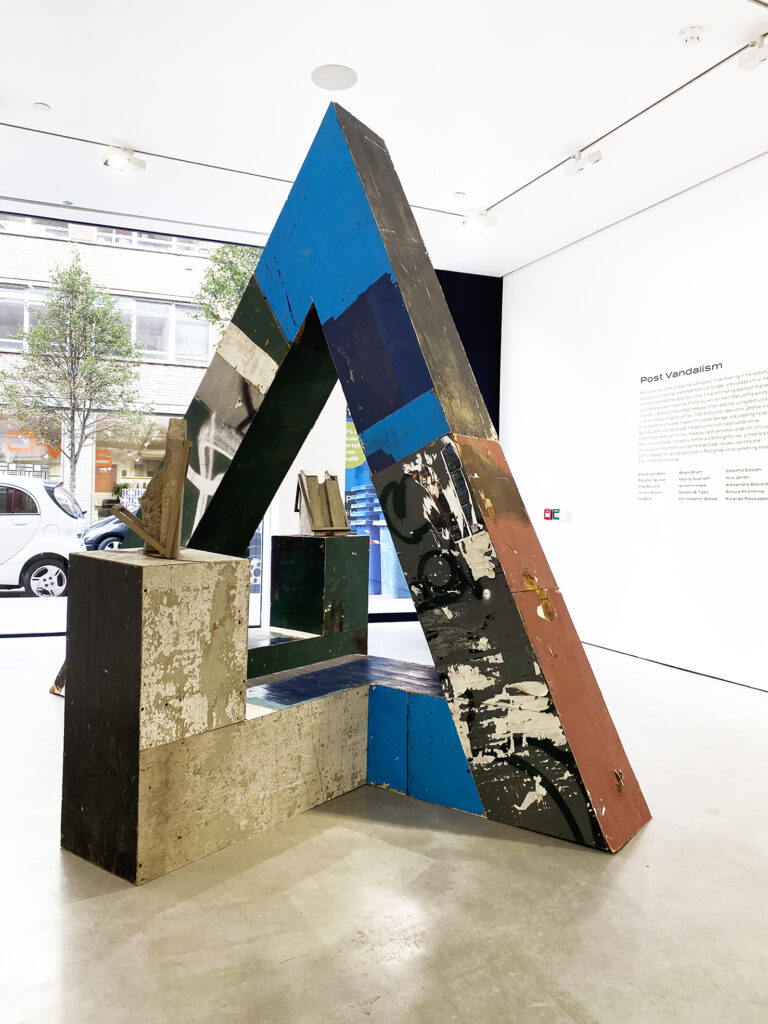
MB:It’s amazing that you mention Mark Fisher– my good friend JK (aka Nathan Clear) first introduced me to Mark Fisher’s ‘Capitalist Realism’ whilst I was working on the OHSH projects show. I really got into it, and also read ‘Flatline Constructs’. I was immediately drawn to the term ‘hauntology’, and saw parallels with my work, so your reading is spot on.
‘Techno Gothic’– amazing term. I’m also heavily influenced by the work of Ramelzee, 4https://en.wikipedia.org/wiki/Rammellzeewho coined the term ‘Gothic Futurism’.
There is definitely a dark, eerie edge to my work, and the OHSH projects space was the perfect setting for the show, the atmosphere of the space fed into the work perfectly for me. The large-scale photo you describe is something I’d wanted to do for a long time. It depicted a site from where I’d removed hoardings to use in the sculptures in the show, leaving just the wooden framework to which the wooden sheets were fastened. The framework is the skeleton of the threshold of ownership, if you like, exposed as a feeble, skeletal land grab without the wooden sheets to cover it; this is what ownership really looks like behind the façade. I really find it strange that land on this planet can be bought and owned and passed down through generations, it’s such a strange concept, owning the earth. The photo does fit nicely within Fisher’s ‘failure of absence’ or ‘failure of presence.’ His ‘Flatline Constructs’ ties in with my zine, ‘Fantasy Sculpture Park’, published alongside the exhibition ‘Territorial Gestures’.
JB: Early in his career, Sterling Ruby was playing out a very competitive, oedipal role in relation to preceding generations of sculptors. In his Frieze article on Ruby,5‘Mucking Up the Masters: The Unruly Sculptures of Sterling Ruby’, Frieze Magazine, June 2019Jonathan Griffin describes Ruby’s early works as ‘grubby, emotionally raw retorts to the poker-faced minimalism of Donald Judd, Robert Morris and Tony Smith’; and curator Jed Morse quotes Ruby saying of Los Angeles gang graffiti, ‘I’ve always wanted to do that to a Judd.’
All very predictably macho.
You, on the other hand, tend to focus on a more celebratory approach to cultural production from outside of fine art. Of course, those boundaries have been broken down in many ways since the 1960s; but I would like to consider certain art historical signposts that might point to other things going on in your work.
You have talked a lot elsewhere about your fascination with surfaces: in particular, how materials decay or are in some way assaulted by their environment and its inhabitants. I’m intrigued by this obsession with surface. One thinks here of Warhol:
‘If you want to know all about Andy Warhol, just look at the surface; of my paintings and films and me, and there I am. There’s nothing behind it… I see everything that way, the surface of things, a kind of mental Braille. I just pass my hands over the surface of things.’6‘Andy: My True Story’ Los Angeles Free Press, 17th March 1967
We, however, instinctively want to get below Warhol’s ‘surface’, through reading that ‘mental Braille’. Warhol’s ‘Electric chair’ resonates beyond its kitsch horror and manifests Fisher’s conception of the eerie, because the chair is empty.7One of the most compelling of these chair images hangs in a silver cloying cloud of silkscreen ink, a giant goulish apparition conjured from a newspaper article dated January 13, 1953, that reports the death sentences handed down to Julius and Ethel Rosenberg.
Warhol’s ‘Shadow’ paintings, perhaps, connect more closely with your work: screenprinted photographs of shadows, vague, indefinite spaces rendered in a palette of only two colours whose power comes from their play of dark voids and spatial ambiguities. Do these thoughts chime with you? Do you think it is the play of presences and absences that attracts you to Ostrowski’s work? Am I talking Trip Hop rather than Hip Hop?
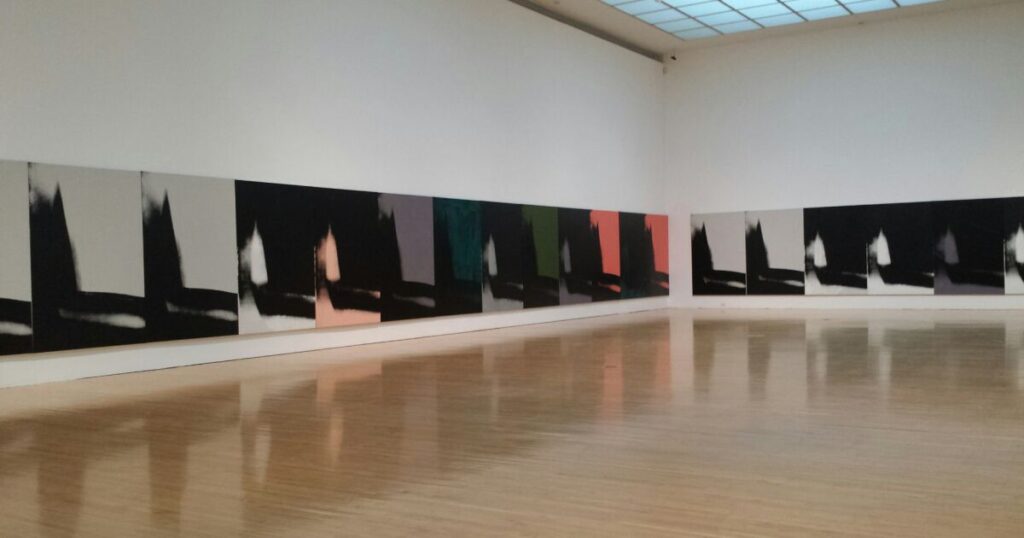
MB: Again, John, I’m super-into what you’re saying, this is really the most interesting interview I’ve ever done. I read your words and they open up my practice, my personal history and my outlook on the world.
The surface has always been fascinating for me, since I first started drawing, and especially when I began writing graffiti, just the most basic things at first, like how a freshly juiced Pentel marker would glide across a plastic-coated surface such as a car park fire exit door, how the marker would feel writing on different surfaces, such as windows, the backs of bus seats, tube doors; the way spray paint has none of the difficulties or surface preferences that marker pens have, the way it can pretty much go on anything, taking on the surface of the wall’s bumps, posts, screws, bolts, covering everything and incorporating it into the painting. I’m thinking of a quote -not sure who said it- that ‘we hang pictures and paintings on walls to make the walls disappear.’ That has always resonated with me. Painting directly onto walls absorbs them and makes them disappear. The painting really does take on the surface of the wall, it has covered it and now it’s the painting’s surface, not the wall’s.

I really love spray paint, although don’t use it much in my practice; just the thought of the medium is so powerful. I love the fact that it’s a hovering motion that makes the painting, that there’s no contact with the surface, that there’s an air gap between the nozzle and the wall, and that there’s room for errors and accidents to occur, the wind affecting the aiming of the paint; I lovethe gestural flowing freedom of there being no friction with the surface.
With regard to surface in my work now, it’s very much about the marks left on the surfaces presented to us in the utilitarian landscape of the city, the marks that bear witness to movement and time, and also to the battle for the surface, the politics, the battle between illicit applications such as graffiti or fly posting and their removers, that leaves traces that function as abstract gestures.
In my work there is a lot in the surface; it’s the provenance and history that makes the surfaces of my sculptures what they are.
I can see the relation to Warhol’s ‘Shadows’. My work carries a lot of ghosts, like sentries on the street, witnessing it all. A cargo of memories, a distillation of the life that’s going past them.
At first, I was only aware of Sterling Ruby’s big poured resin sculptures; only later did I discover his earlier, more blocky, graffiti-coated minimal pieces. I see a correlation, but again, my work is all about the material and its history and form is secondary, little more than a device to present the found surfaces.
I’ve recently learnt how to weld, and I’ve started casting concrete, and I’m using more found materials. I’ve started incorporating these new smaller sculptures into the bigger hoarding structures, making the hoarding sculptures act as both sculpture and plinth. So, my sculptures are now evolving into supports and presentation devices for further sculptures.
The new, smaller sculptures are more like proposals or maquettes for huge outdoor pieces. Combining concrete and metal, they are really quite brutalist abstracts. I’m really excited to explore them further, refining them and experimenting, and to see how they tie into the rest of my practice.
